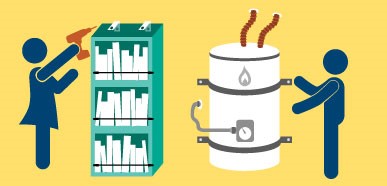By Sean McGowan, Anne Rosinski and Amanda Siok
Sean McGowan, Anne Rosinski and Amanda Siok are the Earthquake Program Managers for FEMA Regions 8, 9 and 10 respectively. They promote awareness of the threat posed by earthquakes and educate the public on how to take action.
Last Thursday was the annual Great ShakeOut Earthquake Drill for many communities around the world. We hope you joined the more than 30 million participants worldwide and used it as an opportunity to practice what you would do if an earthquake struck. The basics of Drop, Cover and Hold On could save your life. The ShakeOut is a great way to maintain readiness and make those response actions second instinct. With those skills as a base, you can start taking the next steps to make your home and your community more earthquake ready.
Spot the Hazards
One of the first actions you can do, and that won’t cost you anything, is to take a look at your home and identify potential hazards during an earthquake. Identifying items that could fall and injure someone is a great start to making your home safer. Once you’ve done that, you can take actions to minimize those risks.
Good starter activities include:
- Strap down televisions, computers and other expensive or hazardous electronics.
- Secure or move heavy pictures and mirrors located over beds or other furniture.
- Brace water heaters and make sure that gas models have flexible connections.
- Know how and when to shut off utilities.
For a full list of earthquake damage prevention measures and retrofits ─ including a cut-away diagram of where these potential hazards can be found in your home ─ download the FEMA brochure Earthquake Home Hazard Hunt.

Anchoring household items can prevent them from hurting someone during an earthquake.
Insuring Your Future
Earthquakes are no-warning events that can significantly disrupt personal, family, and business finances. Earthquake insurance is an important means of protecting your assets should an earthquake occur. Standard homeowners’ insurance generally does not cover damage resulting from land movement or landslides.
Traditional earthquake insurance covers “pure loss” caused by an earthquake. That means the insurance company assesses the value of the items lost as a result of the quake and reimburses you for that specific amount – an amount that will vary from person to person. Parametric insurance is a relatively new approach that insures policyholders against specific events by using parameters (set criteria that apply to everyone) to determine the cost of the damage. Contact your insurance agent to see if one of these options might be right for your household.
Cracking the Code
Another important step in earthquake risk reduction is to ensure that future buildings are built to last. Modern consensus building codes and standards are often seen as an aspirational target to achieve; however, as minimum standards, they were intended to be the floor of what is acceptable to protect lives. Designing structures to withstand natural hazards costs pennies on the dollar upfront, but can save significant costs, and potentially lives, when disaster strikes.
You can find out what code edition, if any, your local jurisdiction enforces at “No Code. No Confidence – Inspect to Protect” online at inspecttoprotect.org. This resource also highlights potential mitigation actions you can take, tailored to the codes enforced and natural hazards faced in your area – with rough estimates of the cost to mitigate.
If you decide structural mitigation or a retrofit project might be right for your home or property, consult with your local emergency management staff. They will be able to advise you on potential access to local, state, tribal and federal mitigation funding opportunities to protect your safety and property. You can also learn more on how to be an advocate for enhanced building codes that protect your entire community.
Moving Forward
Our planet is constantly changing, and earthquakes are a natural part of that activity, albeit one that can bring destruction to our built environment. While earthquakes occur with little warning, we are not powerless in preparing for them. With an understanding of the threat posed by earthquakes, you can make choices that limit the negative impact they have on your household and encourage leaders to make similar decisions benefitting your community.
Helpful Resources
- https://go.usa.gov/xMJgV - Comprehensive earthquake risk information from FEMA and federal partners
- https://www.ready.gov/financial-preparedness - Tips on how to be ready for the financial impact of a disaster
- https://go.usa.gov/xMJaZ - Overview of earthquake insurance and how it can fit into your financial preparedness plan
For more earthquake preparedness tips from Earthquake Program Managers Sean McGowan, Anne Rosinski and Amanda Siok, check out the previous post We Live in Earthquake Country.


